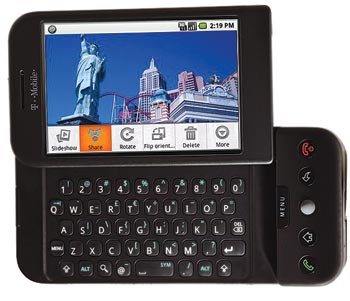In our previous article, we looked at how the Android platform worked and the many of the features of other smartphone operating systems.For example, Android offered no Microsoft Exchange support upon release. Many companies use Microsoft Exchange as a platform for e-mail and scheduling applications.


In our previous article, we looked at how the Android platform worked and the many of the features of other smartphone operating systems.
For example, Android offered no Microsoft Exchange support upon release. Many companies use Microsoft Exchange as a platform for e-mail and scheduling applications.
But because of the open source nature of Android and Google’s support for third-party developers, it didn’t take long before a company offered an application that would sync Exchange functions with the phone.
The Android platform may have to play catch up with the other operating systems on the market; it may have the ability to go even farther than them.
Several handsets use the Android operating system. The flexibility and ease of modifying this OS has made it a leader in its own right.
Google has made several handsets (via its partners), most of these use the Android operating system. There’s the HTC G1, the first smartphone to run on Android in the United States. Verizon offers the Droid, an Android phone built by Motorola.
Several other phones also rely on Android but the Nexus One is the first true Google phone the first phone you can purchase directly from Google.
When Google first issued Nexus One models to its employees, the handsets had no manufacturer markings on the case. Once Google offered the phone to the general public, the hardware included an HTC logo.
The Nexus One is 119 millimetres tall, 59.8 millimetres wide and less than 11.5 millimetres thick. It weighs just 130 grams with the battery installed.
It has a about 9.4-centimeter active matrix organic light emitting diode (AMOLED) display. The display resolution is 800 by 400 pixels and its contrast ratio is 100,000 to 1. The phone uses a 1 gigahertz Qualcomm processor and has 512 megabytes of RAM.
It also has 512 megabytes of Flash memory and comes with a four-gigabyte micro SD storage card. Nexus One owners who want more storage can upgrade up to a 32-gigabyte SD card.
The phone works on the 850, 900, 1800 and 1900 megahertz frequencies on GSM/EDGE cellular networks.
It also has a Wi-Fi receiver that is compatible with 802.11 b and g protocols. The phone supports Bluetooth 2.1 and A2DP stereo Bluetooth. It also has an assisted global positioning system receiver.
The phone’s 5-megapixel camera comes with an LED flash. It also has a digital zoom feature that provides a zoom power of 2X.
The camera can take video at 20 frames per second with a resolution of 720 by 480 pixels. The Nexus One launched with the Android operating system version 2.1, codenamed Éclair.
This version of the OS supports multiple contacts and synchronization applications, allowing developers to create apps that let users manage several e-mail accounts using one device. Anyone wanting to buy an Android phone will have to create a Google account first.
Google accounts are free and you can sign up at any time whether you own an Android phone or not. If you have a Google account, you can access services like Gmail, Google Calendar and Google Docs. Android’s designers built the platform so that it interfaces with these functions smoothly.
eddie@afrowebs.com


